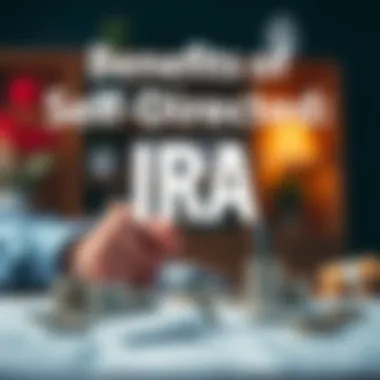Understanding SDIRAs: A Comprehensive Guide


Intro
In the world of personal finance, planning for retirement can feel like trying to navigate a winding road without a map. With numerous options available, Self-Directed Individual Retirement Accounts (SDIRAs) have emerged as a compelling choice for many investors. These accounts offer a level of flexibility and control that traditional retirement accounts may lack, allowing individuals to steer their investment strategies according to their own insights and preferences.
While the concept sounds inviting, SDIRAs also come with their fair share of intricacies and responsibilities. Understanding the mechanics behind these accounts is essential for anyone considering this route. This guide aims to break down the components of SDIRAs, from the legal framework to the investment options they provide, and the potential tax implications tied to them.
Whether you’re a seasoned investor or just starting your journey, clarity about SDIRAs enables informed decision-making, ensuring that your retirement planning strategy aligns with your long-term financial goals. Let's explore the investment dictionary to better familiarize ourselves with key terms and strategies related to SDIRAs.
What is a SDIRA
The world of retirement accounts can be labyrinthine, with options that can leave even the most financially savvy scratching their heads. Among these options, Self-Directed Individual Retirement Accounts, or SDIRAs, stand out as a distinctive choice for investors who want a tighter grip on their retirement strategy.
Just to cut to the chase, a SDIRA allows individuals to take control of their retirement funds by investing in a broader array of assets than typical IRAs. This flexibility can be a double-edged sword though. While many investors thrive on the variety and independence a SDIRA offers, it requires a deeper understanding of regulations, asset classes, and management obligations.
Definition and Overview
A Self-Directed IRA is a type of retirement account that enables investors to allocate their funds across a wide spectrum of investments, not just stocks or bonds. This means you can take a crack at real estate, precious metals, or even cryptocurrencies, all using your retirement savings.
It’s crucial to grasp that while you get a lot of freedom, there’s also a layer of responsibility involved. The account holder isn’t merely a passive investor; they need to be actively engaged and knowledgeable about the choices they make. If you're the type who likes to roll up your sleeves and dig into the nuts and bolts of investing, a SDIRA might be right up your alley.
Historical Context
Understanding SDIRAs can’t be done without a glance at their backstory. These accounts emerged from regulatory shifts in the early 1970s when the U.S. government began to loosen its grip on what individuals could hold in tax-advantaged accounts. The potential for various investments was gradually recognized, pushing the financial industry to create these flexible vehicles.
Initially, most folks were skeptical of SDIRAs, as they were often linked to high levels of risk and poor returns due to lack of experience in alternative investing. However, as more investors learned the ropes and witnessed the benefits, the popularity of SDIRAs began to climb. Today, many see them as a smart strategy to diversify their portfolios and optimize tax benefits—much like adding spices to a well-cooked dish.
By examining both the definition and historical evolution of SDIRAs, investors are better positioned to appreciate their advantages and navigate the complexities that come along with them. The journey into self-directed retirement investing potentially leads to greater wealth and security, but only for those willing to put in the work.
Key Features of SDIRAs
The world of Self-Directed Individual Retirement Accounts (SDIRAs) holds several unique characteristics that set it apart from traditional retirement accounts. Understanding these key features is essential as they dictate not just the operational dynamics of the accounts, but also the greater flexibility and control they provide to investors. Here’s a closer look at the primary elements that distinguish SDIRAs.
Investment Flexibility
When it comes to investment options, SDIRAs are like a buffet offering an extensive range of choices, unlike the usual salad plate you get from conventional IRAs. Instead of being restricted to stocks and mutual funds, SDIRAs allow investors the freedom to venture into various asset classes. This can include real estate, precious metals, cryptocurrencies, tax liens, and even private placements.
- Real estate options are especially attractive, allowing individuals to invest in properties, whether residential, commercial, or raw land. It’s a concrete asset that can appreciate over time, providing not just potential price windfalls but also rental income.
- Precious metals like gold and silver can serve as a hedge against inflation and economic uncertainties. With SDIRAs, one can purchase physical bullion or even rounds of coinage.
- Cryptocurrencies, while relatively new to the investment landscape, are gaining traction among self-directed investors looking to diversify their portfolios further. Think Bitcoin or Ethereum! It's still a wild-west scenario but offers huge potential.
With such a wide array of options at your disposal, the investment flexibility of SDIRAs can cater to diverse risk appetites and financial goals, thus playing a critical role in modern retirement planning.
Control Over Investments
Another standout feature of SDIRAs is the unparalleled control they grant investors over their retirement funds. Unlike traditional retirement accounts that typically require a manager to dictate the course of investments, SDIRAs empower individuals to take the steering wheel themselves. This hands-on management approach allows you to tailor your portfolio directly to your unique preferences and insights.
However, this control comes with the caveat of responsibility. Investors need to be well-versed and cautious about their investment choices — the buck stops with them, after all. Making informed decisions means doing thorough research and possibly engaging with professionals to ensure that the choices align with one's risk tolerance and retirement goals.
In practical terms, this means that an investor might take it upon themself to find lucrative properties or markets and act on them without waiting for a broker's green light. Having direct access and decision-making power can lead to better customization of the investment strategy, ultimately influencing long-term financial outcomes.
Custodianship and Responsibilities
In any Self-Directed IRA, the role of a custodian is crucial. Custodians are financial institutions that manage the account on behalf of the investor. It’s important to choose the right custodian carefully since they facilitate all transactions, manage compliance with IRS regulations, and maintain proper documentation.
Here are some key responsibilities of a custodian in the context of SDIRAs:
- Transactional oversight: They process all investments, ensuring that purchases of assets like real estate or cryptocurrency are done legally and efficiently.
- Regulatory compliance: Custodians help ensure that all investments adhere to IRS guidelines, decreasing the risk of inadvertently falling into prohibited transactions.
- Recordkeeping: Proper records are essential for tax purposes. Custodians maintain records of all transactions and valuations, making it easier for investors when it comes time to file taxes.
Investors must actively communicate with custodians to be informed and make the best use of their SDIRA. While the custodian takes on substantial duties, the investor still retains significant responsibility for maintaining compliance and monitoring their investments.
In summary, understanding the Key Features of SDIRAs—from the remarkable investment flexibility and control to the vital role played by custodians—provides a foundational overview for anyone looking to optimize their retirement savings. As with any investment venture, knowledge is power, and knowing these key components can pave the way for a fruitful retirement plan.
Types of SDIRA Investments
Understanding the types of investments available through a Self-Directed Individual Retirement Account (SDIRA) is crucial for individuals looking to maximize their retirement savings. This section unpacks the diverse investment options, along with their respective benefits and considerations, providing a clear picture of how SDIRA investments can align with personal financial goals.


Real Estate Investments
Real estate has long been a cornerstone of wealth-building strategies, and SDIRAs provide a pathway for investors to tap into this asset class using their retirement funds. One of the advantages of investing in real estate through an SDIRA is the potential for substantial tax benefits, as the income generated from such investments can grow tax-deferred or even tax-free in the case of a Roth SDIRA.
However, there are critical points to consider. Unlike typical investment accounts, real estate investments require a hands-on approach. Investors should have a keen understanding of the real estate market and be prepared for responsibilities like property management. Moreover, self-dealing rules apply, meaning you cannot buy properties from family members or yourself.
To illustrate, consider an investor who purchases a rental property using an SDIRA. This property generates rental income, which flows back into the IRA tax-free. The investor should account for expenses related to the property, like maintenance and taxes, which must also be handled properly under IRS guidelines to avoid penalties.
Precious Metals
Investing in precious metals, like gold or silver, is another appealing option within the SDIRA framework. Many investors view precious metals as a hedge against inflation and economic uncertainty, often bolstering the portfolio through diversification. The IRS allows certain forms of gold, silver, platinum, and palladium coins and bullion to be included in an SDIRA, adding a tangible asset to an otherwise traditional investment portfolio.
That said, there are specific requirements for these investments. The metals must meet certain purity standards and must be stored with an approved custodian to ensure compliance with IRS regulations. This adds a layer of complexity that investors need to navigate. For example, if an investor decides to purchase gold bars instead of coins, they must be sure that every bar is of a minimum defined purity level, or it may not qualify for tax-advantaged treatment.
Cryptocurrencies
Cryptocurrencies have gained significant traction as a viable investment option in recent years, and the ability to invest in them through a SDIRA adds an interesting dimension to retirement planning. Digital currencies, such as Bitcoin and Ethereum, offer volatility and potentially high returns that appeal to investors seeking growth.
However, it’s important to recognize that with high rewards come high risks. The crypto market is notoriously volatile, and the regulatory landscape remains uncertain. Investors should ensure they understand the nature of these assets before investing, as striking the right balance of risk tolerance is essential. Keep in mind that custodians have different policies on cryptocurrency, so finding one that meets your needs is key. As a cautionary note, tax implications for cryptocurrencies are complex, often requiring care to maintain compliance with IRS guidelines.
Private Placements
Private placements are investments in securities that are not offered to the public and are often sold to a small number of select investors. This can include shares in a startup, real estate projects, or even limited partnerships. The inclusion of private placements in a SDIRA allows investors to access unique investment opportunities that may not fit within the stock market mold.
Investors should tread carefully, as these investments typically come with less liquidity and a higher degree of risk compared to public investments. Furthermore, there is a requirement for due diligence; understanding the business model, financials, and overall market potential of the investment is vital. For example, investing in shares of a promising startup could yield high returns if successful, but there’s the ever-present caveat of potential loss if the venture fails.
To summarize, the various types of investments available through SDIRAs—real estate, precious metals, cryptocurrencies, and private placements—provide a wealth of options for diversifying an investment portfolio. While they each come with their own set of benefits and considerations, careful planning, and strategic decision-making are paramount for making the most of an SDIRA. By understanding these investment types in detail, individuals can leverage their retirement accounts effectively, aligning investments with their long-term financial strategies.
"The diversification offered by SDIRAs through various investments can be the key for many in achieving robust retirement goals."
For more information on SDIRAs and investment strategies, you might find this article helpful.
Benefits of Investing Through an SDIRA
Investing through a Self-Directed Individual Retirement Account (SDIRA) brings a wealth of advantages. Understanding these benefits helps investors make informed decisions that may lead to a more secure financial future. Not only does an SDIRA offer unique investment opportunities, but it also provides significant financial flexibility. Here we break down three main benefits: tax benefits, diversification opportunities, and long-term growth potential.
Tax Benefits
One of the cornerstones of an SDIRA's appeal lies in its tax benefits—an attractive feature for many investors. Contributors to a traditional SDIRA enjoy tax-deferred growth on their investments. This means that as your investments gain value over time, you won’t owe taxes on the gains until you begin withdrawing funds. It’s like a financial time capsule where your money can grow without the usual tax hurdles.
Conversely, if an individual opts for a Roth SDIRA, the scenario flips. Investors pay taxes on their contributions but can withdraw funds tax-free during retirement. This option can be particularly beneficial if one anticipates being in a higher tax bracket down the line. In either case, the tax advantage provides a powerful incentive to invest retirement funds into an SDIRA.
"Tax benefits not only enhance growth but also extend to the types of investments you can hold in an SDIRA, leading to additional layers of financial strategy."
Diversification Opportunities
Another standout benefit is the diversification opportunities that an SDIRA allows. Unlike standard IRAs, which often restrict investments to traditional stocks and bonds, SDIRAs open a whole new world of investment possibilities. You can invest in real estate, precious metals, private placements, and even cryptocurrencies.
This ability to diversify is crucial for any savvy investor. Some choose to invest in a mix of assets to cushion against market volatility. For instance, while the stock market may take a dive, tangible assets like real estate or gold can still maintain value. This diversity in holdings can help manage risk and enhance overall portfolio robustness.
Moreover, SDIRAs allow investors to are strategic about their choices, enabling them to align their assets with their individual risk tolerance and financial goals.
Long-Term Growth Potential
Lastly, the long-term growth potential associated with SDIRAs is impressive. Investing within the framework of an SDIRA allows for compounding returns over time, amplifying the effect of both tax advantages and diversified investments.
The flexibility in choosing investments that align with personal interests or expertise can lead to greater engagement and potentially higher returns. For example, an investor with knowledge in real estate might find significant opportunities, unlocking value well beyond typical stock market returns.
Additionally, the absence of mandatory withdrawals until age 72 (as per the current IRS guidelines) grants investors the patience to weather economic downturns. If the market is not favorable, patience can lead to a fruitful long-term strategy.
Investing through an SDIRA thus represents not only smart financial planning but also the opportunity for meaningful retirement savings that can carry individuals through their golden years. By understanding these benefits, investors can wield their accounts more effectively.
Legal and Regulatory Framework
Understanding the legal and regulatory framework surrounding Self-Directed Individual Retirement Accounts (SDIRAs) is essential for anyone looking to navigate this complex investment landscape. The rules established by the Internal Revenue Service (IRS) and other regulatory bodies shape how these accounts can be utilized, as well as the types of investments they can hold. Awareness of these guidelines can help an investor maximize their returns while staying within the confines of the law, thus avoiding potential penalties.


IRS Guidelines for SDIRAs
The IRS sets forth specific guidelines that govern the establishment and management of SDIRAs. These rules dictate everything from contribution limits to the types of assets permissible for investment. For instance, the IRS mandates that self-directed IRA owners must have a qualified custodian manage their accounts. This is not just a formality; custodians hold the assets and ensure that transactions comply with federal regulations.
Moreover, the IRS caps annual contributions to SDIRAs. It’s typically an annual limit based on the investor's age and the type of account. For example, as of recent years, individuals under 50 can contribute a certain maximum amount, while those older can catch up with a higher limit. It's wise for investors to consult IRS resources like IRS.gov to stay updated on any changes in regulations or limits.
Prohibited Transactions
Understanding prohibited transactions is crucial for SDIRA holders, as violating these rules can result in disqualification of the IRA and unintended tax consequences.
Self-Deals
Self-dealing occurs when an individual engages in transactions that benefit themselves, their business, or relatives using funds inside their SDIRA. This includes buying property for personal use or selling personal assets to the SDIRA. The IRS sees this as a conflict of interest and explicitly prohibits such activity. Ignoring these rules can lead to hefty penalties, including immediate taxation on the account.
Key characteristic: The main draw of self-deals is the potential for quick returns; however, investors must steer clear of this path to safeguard their tax-advantaged status. The unique aspect of self-deals lies in their appeal—they often seem like low-hanging fruit for an experienced investor but come with a variety of risks that can be damaging long-term.
Disqualified Persons
Disqualified persons include family members and business partners, those who have transactions with the SDIRA that can compromise its integrity. Engaging in transactions with these individuals can lead to the same self-dealing repercussions. Investors often overlook whom they classify as disqualified, leading to unintentional violations. Understanding these rules helps one to maintain the tax benefits associated with their SDIRA.
Unique feature: The unique consideration here is that the definition of a disqualified person extends beyond close family. It can encompass goals tied to business partners and their employees. Thus, keeping this framework in mind is vital for not inadvertently triggering violations.
Unrelated Business Income Tax (UBIT)
UBIT is applicable to income generated from business activities conducted through an SDIRA that are not typically exempt under normal circumstances. For instance, if a rental property generates income, it might trigger UBIT if the income exceeds certain thresholds. This law serves to ensure that SDIRA income maintains its tax-advantaged status without unfair advantages over taxable entities.
Key characteristic: A notable upside is that UBIT may allow investors to offset losses through standard deductions, providing flexibility in loss management. However, a downside is that it interjects additional complexity into already complicated tax situations, and savvy investors should proactively plan for this tax when generating income through their SDIRA.
As you prepare to delve into the investment opportunities that SDIRAs offer, it’s vital to carry forward this understanding of the legal landscape. Navigating within these parameters helps individuals carve out a path for successful investment while avoiding potentially costly pitfalls.
Risks Associated with SDIRAs
When considering Self-Directed Individual Retirement Accounts (SDIRAs), it's crucial to comprehend the inherent risks that accompany these investment vehicles. While SDIRAs offer flexibility and control, they also expose investors to certain hazards that can impact their retirement savings. Understanding these risks can assist you in making more informed decisions as you build your investment strategy. Here, we'll explore three primary risks: market risks, liquidity challenges, and regulatory risks.
Market Risks
Market risks pertain to the volatility of the investments held within an SDIRA. Unlike traditional IRAs that may primarily include stocks and bonds, SDIRAs can hold a wide array of assets, including real estate, private businesses, and even cryptocurrencies.
However, with this expanded portfolio comes a greater exposure to market fluctuations. For instance, if you invest in real estate, changes in the housing market can drastically affect property values. If the market takes a nosedive, your asset's worth might plummet, impacting your overall retirement savings.
In addition, if you're dealing with alternative investments like startups or private equity, the risk is magnified. These investments may be tied to specific sectors or economic conditions that can change, leading to losses. Here are a few situations that illustrate possible market risks:
- Economic Decline: A recession could diminish your stock or real estate investment values significantly.
- Sector-specific Risks: Failure of a particular industry can affect your private business investment.
- Long-term Liquidation: If your SDIRA holds illiquid assets, you might find it hard to cash out when the market turns against you.
Liquidity Challenges
Another risk that comes with SDIRAs involves liquidity, or how easily you can convert your investments into cash. Traditional investment accounts often contain stocks and bonds that can be sold quickly. However, many assets within SDIRAs—such as real estate, private equity, or even artwork—can take time to sell.
This lack of liquidity means you might find yourself in a pinch if unexpected expenses arise when your assets are tied up in non-liquid investments. If you need funds for sudden medical bills or other emergencies, and your primary asset is real estate, you might have difficulty accessing liquidity unless you go through an extensive selling process. Here are some points to remember:
- Asset Type: Real estate and similar investments often take longer to sell precisely because they require finding a buyer.
- Market Timing: If you're forced to sell during a downturn, you could end up accepting a loss just to access the cash you need.
- Cash Reserves: Maintaining cash reserves outside of your SDIRA can mitigate this risk.
Regulatory Risks
Lastly, navigating regulatory risks is essential for SDIRA holders. The IRS has specific rules governing self-directed accounts, and failing to adhere to these regulations can result in penalties or jeopardize your tax advantages. For instance, engaging in prohibited transactions—like lending to yourself or investing in collectibles—could trigger taxes or penalties.
Be aware of the following regulatory pitfalls:
- Self-Deals: Transactions that benefit you personally, such as renting your own property to your SDIRA, may violate IRS rules.
- Disqualified Persons: Family members or other specified individuals cannot benefit from the SDIRA's investments.
- Unrelated Business Income Tax (UBIT): If your SDIRA engages in a trade or business, you may have to pay UBIT, eroding your tax benefits.
Understanding and managing these risks can help you navigate the complex landscape of SDIRAs more effectively. Engaging with experienced custodians or financial advisors can provide invaluable insights into compliance and best practices.
"Investing without understanding risks is like sailing without a map; you might reach your destination, but you’re bound to encounter some stormy seas."


By acknowledging these risks and preparing to mitigate them, you can harness the full potential of your SDIRA while protecting your retirement investments.
Establishing a SDIRA
Setting up a Self-Directed Individual Retirement Account (SDIRA) is an essential step for those who wish to take control of their retirement investments. This section focuses on the importance of establishing an SDIRA, exploring crucial elements and practical considerations involved in the process.
Choosing to establish a SDIRA allows investors to harness a diverse array of investment options. Unlike traditional retirement accounts, which may limit choices to stocks and mutual funds, a SDIRA opens up pathways to investing in real estate, precious metals, and beyond. This flexibility can lead to a more personalized investment strategy, catering to individual risk appetites and financial goals. Furthermore, the control implied in self-direction speaks volumes for financial enthusiasts seeking autonomy in their retirement planning.
"Having control over your retirement investments is empowering, but it comes with its own set of responsibilities and challenges."
Choosing a Custodian
The selection of a custodian can be a pivotal step in establishing a SDIRA. Not all custodians are created equal, and finding the right one can significantly impact the way you manage your account. Custodians are institutions or firms that handle the administrative tasks of a SDIRA, ensuring compliance with IRS regulations while providing access to various investments.
When selecting a custodian, consider the following factors:
- Experience and Expertise: Ensure the custodian has a solid track record in managing SDIRAs and understands the unique rules governing them.
- Fees Structure: Different custodians have various fee models, including setup fees, annual fees, and transaction costs. Choose one that aligns with your investment style and expected activity level.
- Investment Options: Not all custodians offer the same range of investment choices. Some may specialize in real estate, while others excel in commodities or cryptocurrencies.
- Customer Support: Strong support can be vital, especially when navigating more complex investment options. A custodian with responsive and knowledgeable support can ease the learning curve often associated with SDIRAs.
Setting Up the Account
Once a custodian is selected, the next step is to set up your SDIRA account. This process generally involves:
- Application Submission: Fill out the custodian's application form, providing necessary personal information and acknowledging understanding of responsibilities.
- Account Designation: Clearly specify whether the account will be a Traditional, Roth, or other tax-advantaged SDIRA. This choice will carry significant implications for how taxes are handled on contributions and withdrawals.
- Funding the Account: Once approved, the account needs funding to commence investment activities, which brings us to the next crucial step.
Fund Contributions
Funding a SDIRA can occur through several methods, each with its own considerations. Understanding these options ensures you capitalize on the potential of your investment strategy:
- Direct Contributions: You can directly transfer funds into your SDIRA, subject to annual contribution limits set by the IRS.
- Rollovers from Existing Retirement Accounts: This is a common method that allows individuals to transfer funds from pre-existing accounts, such as a 401(k) or other IRAs, without tax penalties—provided it is done correctly within the guidelines.
- Employer Contributions: Some employers offer options to contribute to employee SDIRAs directly, a potential perk many overlook.
Navigating this aspect is crucial, as contributions can directly affect your overall retirement strategy and tax situation.
By successfully establishing a SDIRA, selecting the right custodian, setting up the account correctly, and ensuring apt funding, investors empower themselves to steer their retirement journey with a sense of ownership and strategy. This step is not just about putting money away—it's about crafting a financial future tailored to individual goals.
Managing Your SDIRA
Managing your Self-Directed Individual Retirement Account (SDIRA) is critical for both maximizing investment potential and adhering to regulations. While having control over your retirement investments is a double-edged sword, the benefits can be substantial if approached thoughtfully. The manner in which one's SDIRA is handled can significantly dictate the overall success and growth of retirement funds.
Investment Strategy Development
Crafting a solid investment strategy is foundational in managing an SDIRA effectively. Unlike traditional retirement accounts where options may be limited to stocks and bonds, SDIRAs allow a wealth of choices – from real estate to cryptocurrencies. Therefore, it’s essential to consider a diversified approach to mitigate risks and harness growth.
- Assess Your Financial Goals: Understand what you want to achieve with your investments. Is it financial independence, wealth generation, or perhaps a stable source of income during retirement?
- Research Different Asset Classes: Dive into the specifics of each investment type available within an SDIRA—each asset class behaves differently and carries its own risks and rewards.
- Risk Tolerance: Knowing your comfort level with risk is crucial. Are you someone who can weather market ups and downs, or do you prefer steady growth with less volatility?
- Periodic Review and Adjustment: The investment landscape can shift dramatically. Keeping a close eye on both market conditions and your financial situation can prompt necessary adjustments to your strategy.
Collaboration with a financial advisor familiar with SDIRAs can also provide critical insights, especially for nuanced asset types that require deeper understanding.
Monitoring Investments
Once the investment strategy is set, ongoing monitoring is essential to keep your SDIRA aligned with financial objectives and compliance standards. Without diligence, what once flourished could falter quickly. Here are key strategies:
- Regular Performance Reviews: Set intervals—monthly, quarterly, or annually—to assess your investments. Look not just at returns but also at how each investment aligns with your overarching goals.
- Stay Updated on Market Trends: Investment environments change continuously. Knowing the market dynamics is necessary to make timely decisions.
- Compliance Audits: It’s imperative to ensure that your transactions remain within IRS guidelines for SDIRAs. This involves understanding what constitutes prohibited transactions and ensuring you steer clear of them. Review your account regularly to spot any potential red flags before they escalate.
- Engage with Professionals: Being part of online forums, such as Reddit, or connecting with investment groups on platforms like Facebook can provide community insight and tips on managing your accounts effectively.
"The devil is in the details."
This saying rings especially true when managing SDIRAs. Missing a small detail can lead to significant consequences. Whether that’s a missed opportunity for a lucrative investment or an oversight in compliance that could trigger penalties, astute management is indispensable.
Ultimately, managing your SDIRA is not just about choosing investment options; it’s an ongoing process of evaluation and adjustment. Adopting proactive strategies can help navigate the complexities and optimize the benefits SDIRAs present.
Ending
The conclusion serves as the capstone of this exploration into Self-Directed Individual Retirement Accounts (SDIRAs). Synthesizing the information laid out throughout the article, it emphasizes the critical insights gathered and sheds light on their implications for investors. In a world where retirement planning is more crucial than ever, SDIRAs offer unique opportunities and certain responsibilities that must not be overlooked.
Recap of Key Points
To summarize:
- Investment Flexibility: SDIRAs provide a wider array of investment options compared to traditional IRAs, allowing for diverse portfolios including real estate, precious metals, and even cryptocurrencies.
- Custodianship Responsibilities: The custodian plays a pivotal role. It is important to choose one that aligns with your investment goals and is knowledgeable about various asset types.
- Legal Awareness: Understanding IRS guidelines, prohibited transactions, and potential tax implications is vital to avoid hefty penalties and ensure compliance.
- Risk Consideration: With great flexibility comes inherent risks. Investors should be prepared for market volatility, liquidity challenges, and regulatory changes.
- Strategic Management: Effective management of your investments can yield long-term growth and truly harness the benefits of an SDIRA.
Final Thoughts on SDIRAs
In closing, engaging with SDIRAs can be a double-edged sword. The potential for higher returns and strategic investment choices is alluring, yet it is also layered with complexities. A critical understanding of the legal framework, rigorous due diligence, and a well-planned investment strategy are mandatory. Juggling the freedom of self-direction with the responsibilities of managing one's retirement investments can be a formidable task; however, for those willing to step up to the plate, the rewards can be considerable.
Ultimately, the savvy investor can navigate these waters effectively, unlocking the potential of SDIRAs to create a robust retirement savings strategy. For further reading, visit Investopedia or check out IRS Guidelines on SDIRAs to stay current on best practices and regulatory matters.



